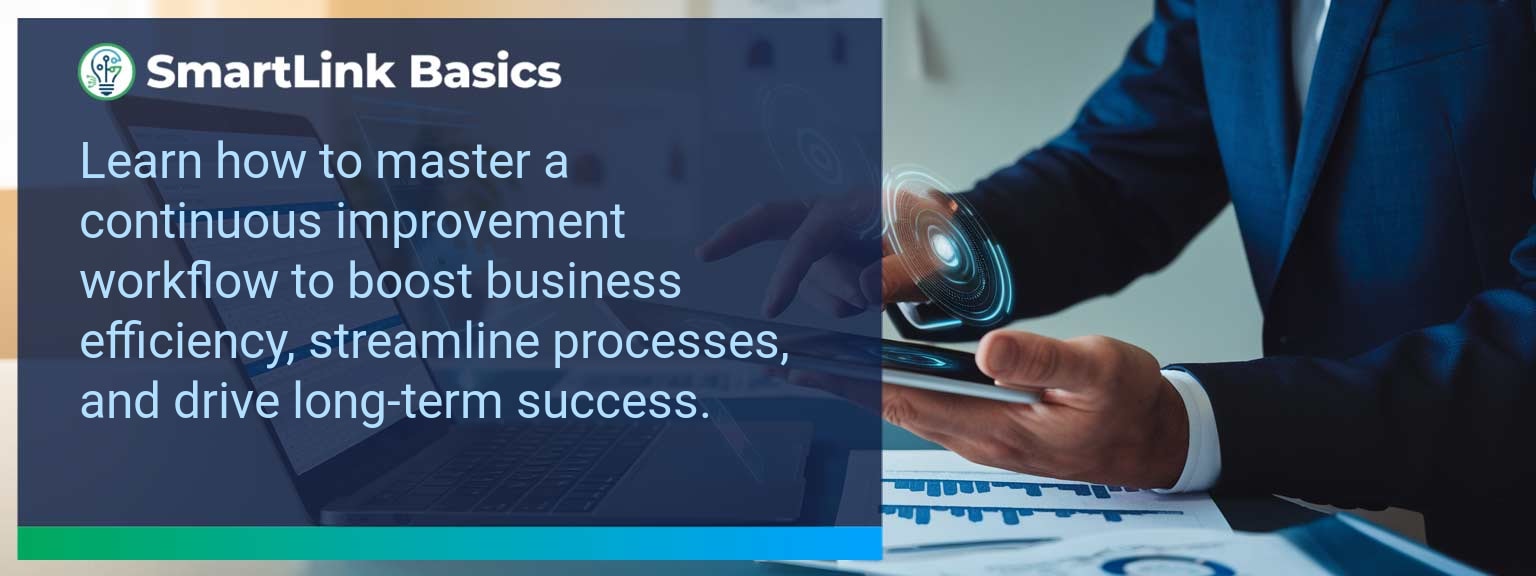High-performing sales organizations treat operational excellence as an ongoing discipline, not a one-time initiative. At SmartLink Basics, we help sales leaders operationalize that discipline through a structured Continuous Improvement Workflow that aligns teams, metrics, and execution in the AI-driven marketplace. Implementing a repeatable process for process optimization, workflow management, and business efficiency ensures that each improvement cycle compounds results. This article breaks down how to identify improvement opportunities, remove bottlenecks, apply lean methodology principles, and measure gains, so you can streamline operations and drive measurable revenue growth.
- Establish a structured framework for ongoing workflow evaluation.
- Use real-time data to pinpoint bottlenecks and inefficiencies.
- Apply lean and kaizen process techniques to optimize execution.
- Standardize improvements into documented playbooks.
- Track progress with both leading and lagging indicators.
What Changed And Why The Continuous Improvement Workflow Matters
Sales leadership now operates in rapid cycles of change driven by AI, automation, and shifting buyer behaviors. Without a Continuous Improvement Workflow, process inefficiencies linger and compound, eroding margins and slowing revenue velocity. Applying structured process mapping and operational excellence principles ensures your team acts on accurate data instead of reactive assumptions. For example, a sales operations team running quarterly workflow audits reduced sales cycle length by 12% in six months. Establish a cadence for reviewing workflows that matches the pace of market dynamics.Redesign The Revenue Operating System With Continuous Improvement Workflow
ICP, Segmentation, and Targeting Precise targeting prevents wasted effort. Map your Ideal Customer Profile (ICP) quarterly, using AI analytics to refine segments. A well-defined ICP enables better alignment between marketing, sales, and customer success. Pipeline Architecture Structure your pipeline stages to reduce friction points between marketing-qualified and sales-qualified stages. Revise stage definitions and exit criteria so forecasting accuracy improves. Plays and Messaging Document best-performing plays and refresh them based on market feedback. High-conversion messaging should flow directly from updated ICP and segmentation work. Operating Cadence Institutionalize a rhythm for deal reviews, pipeline inspections, and rep development sessions. A stable cadence keeps process optimization initiatives visible and actionable.Common Roadblocks To Ongoing Process Development
The most frequent barriers are lack of data visibility, absence of a designated owner, and cultural resistance to change. Without transparent data, workflow management becomes guesswork. For example, a company using outdated CRM reports missed underperforming campaign trends for nearly two quarters. Assign a process champion and integrate cross-functional reviews to maintain momentum.Strategic Approaches For Optimizing Efficiency
Lean methodology offers proven tactics for removing waste while the kaizen process drives incremental gains. Companies embedding small-scale daily experiments into regular operations often see measurable improvements within weeks. A practical step: pilot an automation in one pipeline stage and measure impact before scaling. By embedding these practices, efficiency gains compound.Positive Impact Of Implementing Improvements
A refined Continuous Improvement Workflow can cut operating costs, improve forecast accuracy, and elevate customer experiences. One B2B sales team increased win rates by 14% after standardizing handoffs and introducing a structured feedback loop. Track and share wins internally to reinforce adoption.Adapting Workflow Strategies For Future Growth
Market conditions will continue to evolve, and so must your workflows. Data integration, AI forecasting, and continuous skill development must become part of your operational DNA. Build a scalable improvement loop so your processes stay relevant as your business grows.Metrics That Matter
| Category | Metric | Definition | Target |
|---|---|---|---|
| Leading | Process Cycle Time | Average days to complete a workflow cycle | -15% from baseline |
| Lagging | Win Rate | Percentage of qualified deals closed | +10% in 12 months |
| Quality | Process Adoption Rate | Percentage of team consistently applying new process steps | >90% |
Get the 90-day plan, coaching rubric, and dashboard template to operationalize AI in your enablement program.









